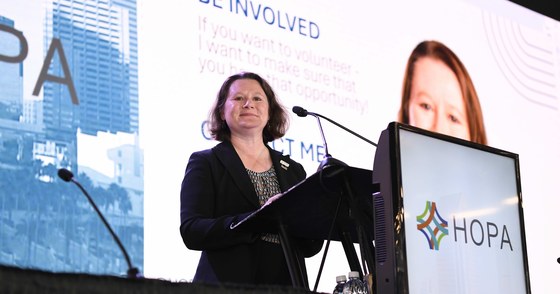2023 Tandem Meetings: Transplantation & Cellular Therapy Meetings of ASTCT™ and CIBMTR®
Arpita Gandhi, PharmD, BCOP, Hematology/Oncology Clinical Pharmacy Specialist at Emory Healthcare – Winship Cancer Institute

Introduction
The in-person annual Transplantation & Cellular Therapy Meetings of ASTCT™ (American Society for Transplantation and Cellular Therapy) and CIBMTR® (Center for International Blood and Marrow Transplant Research) took place from February 15-19, 2023 in Orlando, FL.
Leading experts in the field of transplantation and cellular therapy from around the world presented on various topics including cutting-edge clinical and translational research, progression in the prevention and treatment of acute and chronic graft versus host disease (GVHD), present and future directions of transplant infectious diseases, outcomes measurement for transplant and cellular therapy, and so much more. ASTCT celebrated the inaugural GVHD Day on February 17, 2023. The goal of GVHD Day was for the organization to collectively show support for all those impacted by GVHD.
Highlight 1: Hematopoietic Stem Cell Transplantation Considerations in Older Adults/Elderly Patients1
Dr. Jill Ferguson and Mr. Nick Szewczyk, APRN presented a BCOP session on risk factors that place elderly allogeneic hematopoietic cell transplantation (alloHCT) recipients at a higher risk of non-relapse mortality. The presenters also discussed strategies to decrease adverse drug events (ADEs) in these patients to improve their overall outcomes post alloHCT.
Presentation key points:
- Given the rise in the number of elderly patients undergoing alloHCT, it’s important to consider optimizing conditioning regimens to include reduced-intensity conditioning and non-myeloablative conditioning, utilizing a combination of therapy with a favorable toxicity profile (e.g., less use of methotrexate and anti-thymocyte globulin), and ensuring that appropriate supportive care measures are in place. Examples of supportive care measures to consider include the following: cryotherapy to prevent mucositis with melphalan, hydration to prevent hemorrhagic cystitis with post-transplant cyclophosphamide, and appropriate skincare for patients receiving thiotepa.
- Medication challenges in geriatric patients include polypharmacy, ADEs, drug interactions, inappropriate prescribing, and medication nonadherence. Pharmacists play a key role in improving outcomes in these situations.
Highlight 2: It’s Time to ParT(y) with CarT: The Role of CAR T-cells in Multiple Myeloma2
Dr. Kathryn Maples presented on the role of B-cell maturation antigen (BCMA) targeted therapies as well as CAR T-cell therapy for the treatment of patients with newly diagnosed and relapsed/refractory (R/R) multiple myeloma (MM). There was a comprehensive discussion on various patient, disease, and treatment related factors that should be considered when determining the CAR T-cell therapy eligibility of a patient with MM.
Presentation key points:
- MM remains an incurable disease, therefore optimal selection and sequencing is critical in order to prolong life. In recent years, novel therapeutic strategies as well as optimal sequencing has focused on achieving a deeper depth of response and a prolonged duration of response associated with the first remission.
- Recently approved BCMA targeted therapies include CAR T-cell therapies idecabtagene vicleucel (ide-cel) and ciltacabtagene autoleucel (cilta-cel), both of which are FDA approved for the treatment of R/R MM after failing four or more prior lines of therapy. Teclistamab, a bispecific antibody targeting BCMA and CD3, was recently approved by the FDA for a similar indication.
- Ide-cel and cilta-cel have demonstrated deep and durable responses in heavily pretreated patients in the KarMMA and CARTITUDE-1 trials, respectively. A notable difference between these therapies is the median time to cytokine release syndrome (CRS) which was reported as 1 day with ide-cel versus 7 days with cilta-cel. Additionally, the median time to neurotoxicity onset was reported as 1 day with ide-cel and 8 days with cilta-cel. These notable differences play a key factor for centers that may be considering moving CAR T-cell therapy to the outpatient setting.
- Prognosis remains grim for patients that relapse after CAR T-cell therapy. Therefore, the following areas remain under active investigation: moving CAR T-cell therapy earlier in the treatment algorithm, combining CAR T-cell therapy with other agents, maintenance therapy after CAR T-cell therapy, and proper sequencing of BCMA-directed therapies.
Highlight 3: Best Practice Panel: Transplant & CAR-T Vaccines: How, Where, When, & Why3
Drs. Alycia Hatashima, Susie Long, and Robert Mancini held a panel discussion focusing on current guideline recommendations for post-HCT and post-cellular therapy vaccination. Additionally, the panel discussed the complexities and challenges associated with titer-based vaccination and the pharmacists’ role in timely administration of vaccines.
Presentation key points:
- Recipients of HCT and CAR T-cell therapy need to be re-vaccinated because immune response wanes over time.
- Timing of vaccination post HCT is important because it requires a delicate balance between time unprotected and the ability to mount an immune response. Many studies have shown vaccines to be effective 6-9 months post alloHCT. Dosing and type of vaccine formulation play a key role in mounting an effective immune response post HCT. For example, DTap has shown higher response rate and lower ADEs compared with Tdap in adult allo HCT recipients. Additionally, conjugated vaccines have shown superiority compared to polysaccharide formulations and are better for priming and inducing immunologic memory.
- Live vaccines are generally contraindicated according to the 2-1-8 rule (less than 2 years post-transplant, less than 1 year off immunosuppression [including maintenance therapies], and less than 8 months out from IVIG).
- Benefits for titer-based vaccination include the following: assessing vaccine response in patients receiving maintenance or treatment for disease relapse, evaluating durable antibody titers during long term follow up, measuring response during vaccine preventable disease outbreaks, and monitoring response in the setting of heterogeneous predictors of poor response. Challenges of titer-based vaccination include variable definitions of response, heterogeneous titer cutoffs, and assay variability.
- Pharmacists play an integral role in administration of vaccines, managing the vaccination process, ensuring appropriate vaccines are administered at appropriate time frames, ensuring vaccine availability, addressing patient and caregiver concerns and questions related to vaccines, and influencing attitudes regarding vaccines.
Highlight 4: The Great Debate: GVHD Prophylaxis Strategies4
Drs. Arpita Gandhi, Rebecca Gonzalez, and Alexis Kuhn discussed safety and efficacy data of various GVHD prophylaxis strategies for adult and pediatric patients undergoing matched-related donor (MRD), matched-unrelated donor (MUD), or mismatched-unrelated donor (MMUD) alloHCT.
Presentation key points:
- When analyzing literature for GVHD prophylaxis, it is critical to be mindful of heterogeneity in the following variables which limit our ability to generalize practice: donor type, graft source, conditioning intensity, and target population. We must be cautious about comparing apples to oranges to pizzas while evaluating GVHD literature. Data in adult patients discussed below is specifically for patients receiving peripheral blood stem cells (PBSCs).
- Viable GVHD prophylaxis strategies for the MRD setting include: calcineurin inhibitor (CNI)/methotrexate, CNI/sirolimus, and post-transplant cyclophosphamide (PTCy) plus one or more immunosuppressant. Of note, PTCy monotherapy in this setting is associated with high rates of severe GVHD and therefore should be avoided. In contrast, options for children undergoing MRD alloHCT with MAC include CNI monotherapy, CNI plus anti-metabolite, and PTCy monotherapy (bone marrow source).
- CTN1703-PROGRESS III trial hailed PTCy/Tac/MMF superior to Tac/methotrexate in the MRD reduced intensity conditioning (RIC) setting by meeting its primary endpoint of GVHD free relapse free survival. However, the study has yet to report outcomes based on donor subtypes; all donor types were included in the trial.
- In the MUD RIC setting, the addition of rabbit ATG has consistently shown to reduce the incidence of grade II-IV aGVHD and cGVHD in numerous studies; however, mortality benefit has yet to be shown. Heterogeneity in ATG formulations, variable dosing and administration schedule strategies, and donor resources limit our ability to make definitive conclusions about the role of ATG in this setting. This is of particular note since the overwhelming majority of these trials pre-date PTCy data.
- In the MUD MAC setting, options for GVHD prophylaxis strategies include Tac/MTX +/- ATG, PTCy/Tac/MMF, and PTCy/Siro/MMF. With regards to PTCy combination strategies, it’s important to note that published literature includes data from single arm studies and therefore caution must be exercised until we have results available from comparative arm trials.
- In the MMUD setting, Tac/MTX/abatacept has the most robust data in terms of efficacy and safety compared to alternative GVHD prophylaxis strategies.
Conclusion
Overall, the 2023 Tandem Meetings included discussions on a variety of topics in the field of transplant and cellular therapy. Some additional exciting presentations not included in the highlights above were on the following topics: treatment options for chronic granulomatous disease, a grant update on the IMPPACT (IMplementation of a Pharmacist-driven Precision medicine service in Adult hematopoietic stem Cell Transplantation) trial, racial and ethnic disparities in the epidemiology and clinical care of MM, pearls for pharmacist-led research in collaboration with other healthcare providers, adolescent and young adult considerations in HCT, updates in clinical practice guideline for the management of Clostridioides difficile infection, and a jam packed two part series on updates from the American Society of Hematology meeting which took place in December 2022.
References
- Ferguson J, Szewczyk N. Hematopoietic stem cell transplantation considerations in older adults/elderly patients. Session presented at: 2023 Tandem Meetings | Transplantation & Cellular Therapy Meetings of ASTCT™ and CIBMTR®; February 17, 2023; Orlando, FL. Maples K. It’s time to parT(y) with CarT: The role of CAR T-cells in multiple myeloma. Session presented at: 2023 Tandem Meetings | Transplantation & Cellular Therapy Meetings of ASTCT™ and CIBMTR®; February 17, 2023; Orlando, FL.
- Mancini R, Hatashima A, Long SE. Best practice panel: Transplant & CAR-T vaccines: How, where, when, & why. Session presented at: 2023 Tandem Meetings | Transplantation & Cellular Therapy Meetings of ASTCT™ and CIBMTR®; February 18, 2023; Orlando, FL.
- Gandhi A, Gonzalez R, Kuhn A. The great debate: Graft versus host disease (GVHD) prophylaxis strategies. Session presented at: 2023 Tandem Meetings | Transplantation & Cellular Therapy Meetings of ASTCT™ and CIBMTR®; February 18, 2023; Orlando, FL.
I recommend the following additional reading:
Attai D, Dizon DS. Social media and oncology: the time is now. JCO Oncol Pract. 2022;18(8):525-527.
Alonso CD, Maron G, Kamboj M, et al. American society for transplantation and cellular therapy series: #5- management of clostridioides difficile infection in hematopoietic cell transplant recipients. Transplant Cell Ther 2022;28(5):225-232.
Shah N, Chari A, Scott E, Mezzi K, Usmani SZ. B-cell maturation antigen (BCMA) in multiple myeloma: rationale for targeting and current therapeutic approaches. Leukemia 2020;34:985-1005.
Waghmare A, Abidi MZ, Boeckh M, et al. Guidelines for COVID-19 management in hematopoietic cell transplantation and cellular therapy recipients. Biol Blood Marrow Transplant 2020;26(11):1983-1994
Lee DW, Santomasso BD, Locke FL, et al. ASTCT consensus grading for cytokine release syndrome and neurologic toxicity associated with immune effector cells. Biol Blood Marrow Transplant 2019;25(4):625-638.
Janssen M, Bruns A, Kuball J, et al. Vaccine responses in adult hematopoietic stem cell transplant recipients: a comprehensive review. Cancers (Basel). 2021;13(23):6140.
Peres LC, Hansen DK, Maura F, Kazandjian D. The knowns and unknowns of disparities, biology, and clinical outcomes in Hispanic and Latinx multiple myeloma patients in the U.S. Semin Oncol 2022;49(1):3-10.

